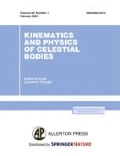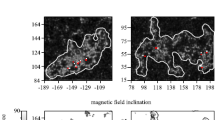Abstract
Results are presented of observations of the facula area near the solar disc center. Observations were performed at the German Vacuum Tower Telescope of the Observatorio del Teide (Tenerife) with the simultaneous use of two instruments, i.e., TESOS in the Ba IIλ 455.4 nm line to measure intensity variations in the photosphere and, at the same time, TIP in the Fe I (λλ 1564.3–1565.8 nm) line to measure Stokes parameters. Using the Fourier filtering technique, we separated the convective and wave components of the intensity field. Stokes parameters Fe I λ 1564.8 nm and λ 1565.2 nm were inverted by the SIR inversion code to estimate the magnetic field strength. We found that the contrast of intergranular lines of the facula in the continuum is almost independent of the magnetic field strengh (in the range from 30 to 160 mT). This result casts doubt on the assertion that solar faculae are a cluster of magnetic flux tubes. Most likely, due to the decrease of transparency of the matter in a strong (approximately 1 kilogauss) magnetic field, we can see the hot walls of granules.
Similar content being viewed by others
References
T. E. Berger, L. H. M. Rouppe van der Voort, M. G. Lofdahl, et al., “Solar Magnetic Elements at 0.1” Resolution. General Appearance and Magnetic Structure,” Astron. Astrophys. 428, 613–628 (2004).
T. E. Berger, A. M. Title, T. D. Tarbell, et al., in Proc. ASP Conf. Ser, Kyoto, Japan, 2005, Ed. by K. Shibata, S. Nagata, and T. Sakurai (ASP, San Francisco, 2007), Vol. 369, pp. 103–111.
R. B. Dunn and J. B. Zirker, “The Solar Filigree,” Solar Phys. 33, 281–304 (1973).
E. N. Frazier, “Mult-Channel Magnetograph Observations. II Faculae,” Solar Phys. 21, 42–53 (1971).
U. Grossmann-Doerth, M. Knolker, M. Schussler, et al., “The Deep Layers of Solar Magnetic Elements, Astron. Astrophys. 285, 648–654 (1994).
E. Khomenko, R. I. Kostik, and N. G. Shchukina, “Five-Minute Oscillations above Granules and Intergranular Lanes,” Astron. Astrophys. 369(2), 660–671 (1994).
M. Knolker, M. Schuessler, and E. Weisshaar, “Model Calculations of Magnetic Flux Tubes. III. Properties of Solar Magnetic Elements,” Astron. Astrophys. 194, Nos. 1–2, 257–267 (1988).
P. Kobel, S. K. Solanki, and J. M. Borrero, “The Continuum Intensity as a Function of Magnetic Field. I. Active Region and Quiet Sun Magnetic Elements,” Astron. Astrophys. 531, A112–A124 (2011).
R. I. Kostik and E. Khomenko, “Observations of a Bright Plume in Solar Granulations,” Astron. Astrophys. 476(2), 341–347 (2007).
R. Kostik, E. Khomenko, and N. Shchukina, “Solar Granulation from Photosphere to Low Chromosphere Observed in Ba II 4554 Å Line,” Astron. Astrophys. 506(4), 1405–1415 (2009).
B. W. Lites, G. B. Sharmer, T. E. Berger, et al., “Three-Dimensional Structure of the Active Region Photosphere as Revealed by High Angular Resolution,” Solar Phys. 221(1), 65–84 (2004).
M. Montagne, R. Muller, and J. Vigneau, “The Photosphere of the Sun: Statistical Correlations between Magnetic Field, Intensity and Velocity,” Astron. Astrophys. 311, 304–310 (1996).
G. Narayan and G. B. Scharmer, “Small-Scale Convection Signatures Associated with a Strong Plage Solar Magnetic Field,” Astron. Astrophys. 524, A3–A19 (2010).
O. V. Okunev and F. Kneer, “Numerical Modeling of Solar Faculae Close to the Limb,” Astron. Astrophys. 439, 323–334 (2005).
B. Ruiz Cobo and J. C. del Toro Iniesta, “Inversion of Stokes Profiles,” Astrophys. J. 398(1), 375–385 (1992).
E. H. Schroter, D. Soltau, and E. Wiehr, “The German Solar Telescopes at the Observatorio del Teide,” Vistas Astron. 28(3), 519–525 (1985).
H. C. Spruit, “Pressure Equilibrium and Energy Balance of Small Photospheric Fluxtubes,” Solar Phys. 50, 269–295 (1976).
R. T. Stebbins and P. R. Goode, “Waves in the Solar Photosphere,” Solar Phys. 110(2), 237–253 (1987).
O. Steiner, “Radiative Properties of Magnetic Elements. II. Center to Limb Variation of the Appearance of Photospheric Faculae,” Astron. Astrophys. 430, 691–700 (2005).
J. O. Stenflo, “Magnetic-Field Structure of the Photospheric Network,” Solar Phys. 32(1), 41–63 (1973).
A. M. Title, K. P. Topka, T. D. Tarbell, et al., “On the Differences between Plage and Quiet Sun in the Solar Photosphere,” Astrophys. J. 393, 782–794 (1992).
K. P. Topka, T. D. Tarbell, and A. M. Title, “Properties of the Smallest Solar Magnetic Elements. I. Facular Contrast near Sun Center,” Astrophys. J. 396, 351–363 (1992).
K. P. Topka, T. D. Tarbell, and A. M. Title, “Properties of the Smallest Solar Magnetic Elements. II. Observations Versus Hot Wall Models of Faculae,” Astrophys. J. 484, 479–486 (1997).
Author information
Authors and Affiliations
Additional information
Original Russian Text © R.I. Kostyk, 2013, published in Kinematika i Fizika Nebesnykh Tel, 2013, Vol. 29, No. 1, pp. 50–57.
About this article
Cite this article
Kostyk, R.I. What are solar faculae?. Kinemat. Phys. Celest. Bodies 29, 32–36 (2013). https://doi.org/10.3103/S0884591313010030
Received:
Published:
Issue Date:
DOI: https://doi.org/10.3103/S0884591313010030




